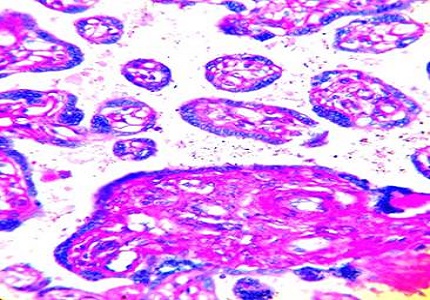Can diabetes with controlled glycemic status cause placental changes and affect foetal outcome? A histomorphology study from a tertiary care centre from Eastern India
Abstract
Background: Normal foetal development and postnatal survival depends on healthy placenta. The adverse effects of diabetes on pregnancy and related foetal outcomes are well established and through this study we have attempted to study the intensity of damage caused, by examining the gross and microscopic features of placenta along with histochemical changes.
Material and Methods: This was a prospective study undertaken in a tertiary teaching hospital in which a total of 80 cases of term pregnancy were studied, out of which 40 were from diabetic mothers and 40 were from non diabetic mothers. Biochemical parameters of all the cases were studied. All placenta were examined on the basis of gross features, histological & histochemical changes.
Results: In the present study, it was noted that gross morphology of placenta was not much altered between diabetic and normal mothers but showed marked variation in the histological findings. On microscopic examination, marked basement membrane thickening, vascular proliferation, chorangiosis, syncytial knots, villous fibrosis and edema were noted among diabetic mothers and most common postnatal complication of newborns among diabetic mothers was macrosomia.
Conclusion: This study highlights the impact of gestational and pregestational diabetes mellitus on placenta as observed by the magnitude of histological changes inspite of having controlled glycemic status either by diet or insulin and associated postnatal morbidities of newborns.
Downloads
References
Hay WW Jr, Catz CS, Grave GD, Yaffe SJ. Workshop summary: fetal growth: its regulation and disorders. Pediatrics. 1997 Apr;99(4):585-91.
Udainia A, Jain ML. Morphological study of placenta in pregnancy induced hypertension with its clinical relevance. J Anat Soc India. 2001;50(1):24-7.
Taricco E, Radaelli T, Nobile de Santis MS, Cetin I. Foetal and placental weights in relation to maternal characteristics in gestational diabetes. Placenta. 2003 Apr;24(4):343-7.
Daskalakis G, Marinopoulos S, Krielesi V, Papapanagiotou A, Papantoniou N, Mesogitis S, Antsaklis A. Placental pathology in women with gestational diabetes. Acta Obstet Gynecol Scand. 2008;87(4):403-7. doi: https://doi.org/10.1080/00016340801908783.
Treesh SA, Khair NS. Histological changes of the human placenta in pregnancies complicated with diabetes. Journal of Cytology & Histology. 2015 Feb 15;6(2):1.
Kheir AE, Berair R, Gulfan IG, Karrar MZ, Mohammed ZA. Morbidity and mortality amongst infants of diabetic mothers admitted into Soba university hospital, Khartoum, Sudan. Sudan J Paediatr. 2012;12(1):49-55.
Farooq MU, Ayaz A, Bahoo A, Ahmad I. Maternal and neonatal outcomes in gestational diabetes mellitus. International Journal of Endocrinology and Metabolism. 2007 Sep;2007(3, Summer):109-15.
Toescu V, Nuttall SL, Martin U, Nightingale P, Kendall MJ, Brydon P, Dunne F. Changes in plasma lipids and markers of oxidative stress in normal pregnancy and pregnancies complicated by diabetes. Clin Sci (Lond). 2004 Jan;106(1):93-8.
Naylor CD, Sermer M, Chen E, Sykora K. Cesarean delivery in relation to birth weight and gestational glucose tolerance: pathophysiology or practice style? Toronto Trihospital Gestational Diabetes Investigators. JAMA. 1996 Apr 17;275(15):1165-70.
Lu GC, Rouse D, Dubard M, Cliver S. The impact of lower threshold values for the detection of gestational diabetes mellitus. Obstetrics & Gynecology. 2000 Apr 30;95(4):S44.
Alam M, Raza SJ, Sherali AR, Akhtar AS. Neonatal complications in infants born to diabetic mothers. J Coll Physicians Surg Pak. 2006 Mar;16(3):212-5.
Banerjee S, Ghosh US, Banerjee D. Effect of tight glycaemic control on fetal complications in diabetic pregnancies. J Assoc Physicians India. 2004 Feb;52:109-13.
Makhseed M, Musini VM, Ahmed MA, Al-Harmi J. Placental pathology in relation to the White's classification of diabetes mellitus. Arch Gynecol Obstet. 2002 Jul;266(3):136-40.
Aladjem S. Morphologic aspects of the placenta in gestational diabetes seen by phase-contrast microscopy. An anatomicoclinical correlation. American journal of obstetrics and gynecology. 1967 Oct;99(3):341-9.
al-Okail MS, al-Attas OS. Histological changes in placental syncytiotrophoblasts of poorly controlled gestational diabetic patients. Endocr J. 1994 Aug;41(4):355-60.
Tewari V, Tewari A, Bhardwaj N. Histological and histochemical changes in placenta of diabetic pregnant females and its comparision with normal placenta. Asian Pacific Journal of Tropical Disease. 2011 Mar 1;1(1):1-4.
Evans MJ. Review: Diabetes and pregnancy: a review of pathology. The British Journal of Diabetes & Vascular Disease. 2009 Sep;9(5):201-6.
Hiden U, Glitzner E, Ivanisevic M, Djelmis J, Wadsack C, Lang U, Desoye G. MT1-MMP expression in first-trimester placental tissue is upregulated in type 1 diabetes as a result of elevated insulin and tumor necrosis factor-alpha levels. Diabetes. 2008 Jan;57(1):150-7. Epub 2007 Oct 10.
Jones CJ, Fox H. Placental Changes in Gestational Diabetes: An Ultrastructural Study. Obstetrics & Gynecology. 1976 Sep 1;48(3):274-80.
Gheorman L, Pleşea IE, Gheorman V. Histopathological considerations of placenta in pregnancy with diabetes. Rom J Morphol Embryol. 2012;53(2):329-36.



 OAI - Open Archives Initiative
OAI - Open Archives Initiative


